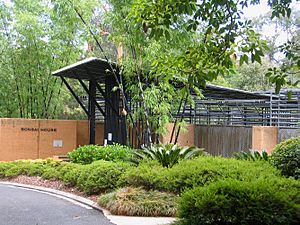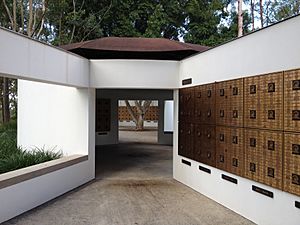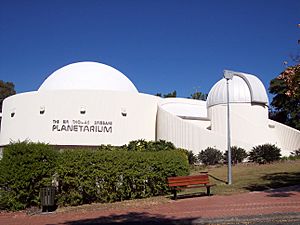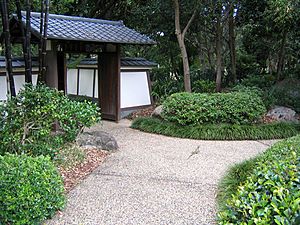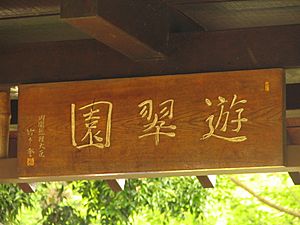Brisbane Botanic Gardens, Mount Coot-tha facts for kids
Quick facts for kids Brisbane Botanic Gardens |
|
|---|---|
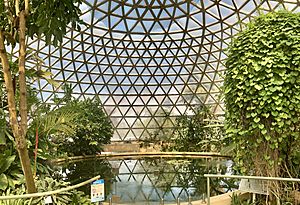
Tropical Display Dome of the Brisbane Botanic Gardens
|
|
| Type | Botanical |
| Location | Mount Coot-tha, Brisbane, Queensland, Australia |
| Area | 52 hectares (130 acres) |
| Owned by | Brisbane City Council |
| Collections | 27°28′35″S 152°58′34″E / 27.4765°S 152.9761°E |
The Brisbane Botanic Gardens are a beautiful place to explore plants from all over the world. They are located at the base of Mount Coot-tha, Brisbane's tallest mountain. This spot is about 7 kilometers (4.3 miles) from the center of Brisbane, Queensland, Australia.
The gardens were once known as the Mount Coot-tha Botanic Gardens. Sometimes people also called them the Toowong Botanic Gardens. They are a popular spot for families and nature lovers.
Contents
Discovering the Gardens' Past
The Brisbane Botanic Gardens are quite large, covering 52 hectares (about 128 acres). The Brisbane City Council created them in 1970. They officially opened to the public in 1976.
These gardens are actually the second botanical gardens in Brisbane. The first ones, now called the City Botanic Gardens, are in the heart of Brisbane. The City Council decided to build new gardens because the old ones couldn't get any bigger. Also, the original gardens often flooded when the Brisbane River rose.
A special library, the Mount Coot-tha Library, also opened at the gardens in 1975.
What Can You See at the Gardens?
The Brisbane Botanic Gardens have many amazing areas to explore. Here are some of the highlights:
- Tropical Display Dome: This large dome opened in 1977. It is 28 meters (92 feet) wide and 9 meters (30 feet) tall. Inside, you'll find plants that love warm, wet weather.
- Japanese Garden: A peaceful garden designed in a traditional Japanese style.
- Bonsai House: See tiny trees grown in pots, shaped to look like full-sized trees.
- Fern House: Home to many different types of ferns.
- Arid Zone and Cactus House: Discover plants that thrive in dry, desert-like conditions.
- Exotic Rainforest: Explore plants from rainforests around the world.
- Australian Rainforest: See plants native to Australia's own rainforests.
- Fragrant Plant and Herb Garden: Smell and learn about plants used for cooking and perfumes.
- Temperate Garden: Plants that prefer milder climates grow here.
- Lagoon and Bamboo Grove: A calm water area surrounded by tall bamboo.
- Australian Plant Communities: Learn about different groups of plants found across Australia.
- National Australia Remembers Freedom Wall: A special place for quiet thought.
The gardens are open every day of the year. From September to March, they are open from 8 AM to 6 PM. From April to August, they are open from 8 AM to 5 PM. It's free to enter the gardens. Remember, dogs are not allowed inside.
Sir Thomas Brisbane Planetarium
Right next to the garden's entrance is the Sir Thomas Brisbane Planetarium. This is a fantastic place to learn about space and stars. It has a special room called the Cosmic Skydome.
The city of Brisbane was named after Sir Thomas Brisbane. He was a governor of New South Wales a long time ago. He was also a famous astronomer. He made maps of the stars in the southern sky while he was in Australia.
Mount Coot-tha Library
The Mount Coot-tha Library is also located at the gardens. The Brisbane City Council runs this library. Unlike most public libraries, this one has a special collection. It focuses on botany (the study of plants) and astronomy (the study of space). This makes sense because it's right next to the botanic garden and the Sir Thomas Brisbane Planetarium.
National Australia Remembers Freedom Wall
On August 15, 1995, Australia celebrated 50 years since the end of World War II in the Pacific. The National Australia Remembers Freedom Wall is a quiet place in the gardens. It is meant for people to think about the sacrifices made for the "Freedom" we have today.
This wall is not a war memorial. Instead, it celebrates 50 years of peace and freedom. There are 16,000 special plaques on the walls. People put these plaques there to remember loved ones or to simply say thank you. The wall's foundation stone was laid on November 11, 1995, and it was officially opened on November 11, 1996.
The Peaceful Japanese Garden
The Japanese Garden was designed by a famous Japanese garden expert, Kenzo Ogata. This was his very last project. The garden follows traditional Japanese garden ideas. But it uses Australian trees, native shrubs, and flowers.
The Japan Pond and Garden was moved here from the Japanese Government Pavilion at Brisbane's World Expo '88. It opened on February 6, 1989, after the Expo finished. This was thanks to the work of Brisbane's Lord Mayor Sallyanne Atkinson and Nichahiro Hanamura from the Japan Association for the Expo.
At the entrance, you'll see a special plaque from the Brisbane City Council. There's also a welcome gate with beautiful writing on a dedication tablet above it. This writing was done by the Japanese Prime Minister at the time, Noboru Takeshita. The golden Japanese writing says "yu-tsui-en." This means "enjoy, blue-green, garden." It's an invitation to "Come in to this garden and enjoy the blue of the water and green of the trees."
The garden's main idea is ‘tsuki-yama-chisen,’ which means ‘mountain-pond-stream.’ You can see this in the garden's water features. Another special part is the stone ‘tsukabai,’ or water bowl. It is over 100 years old. It provides running water for a special cleaning ritual before a Japanese tea ceremony. The most amazing part of the garden is the stones that form the mountain. These stones in the waterfall show "endurance and the eternal passing of time."
In 2005, some bamboo near the Japanese Garden gates flowered. Bamboo flowering is very rare! Many bamboo lovers never see it happen in their whole lives. As often happens after bamboo flowers, this plant died and was replaced.
Every August, the garden hosts an annual Japan Cultural Festival. You can see a Japanese tea ceremony, Japanese calligraphy, and beautiful ikebana flower displays.
See also
 In Spanish: Jardín botánico de Brisbane del Monte Coot-tha para niños
In Spanish: Jardín botánico de Brisbane del Monte Coot-tha para niños


